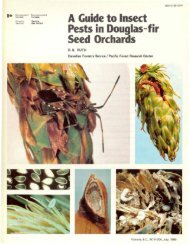decay of aspen and balsam poplar in alberta - Canadian Forest ...
decay of aspen and balsam poplar in alberta - Canadian Forest ...
decay of aspen and balsam poplar in alberta - Canadian Forest ...
You also want an ePaper? Increase the reach of your titles
YUMPU automatically turns print PDFs into web optimized ePapers that Google loves.
Hardwoods, mostly <strong>aspen</strong> (Populus tremuloides<br />
Michx.) <strong>and</strong> <strong>balsam</strong> <strong>poplar</strong> (P. <strong>balsam</strong>ifera L. ), repre·<br />
sent about 40% <strong>of</strong> Alberta's forest resources. Current<br />
utilization amounts to only about 1 % <strong>of</strong> the total, but the<br />
time is fast approach<strong>in</strong>g when the s<strong>of</strong>twood resources will<br />
be harvested to their limits <strong>of</strong> annual allowable cut. The<br />
<strong>aspen</strong>·<strong>balsam</strong> <strong>poplar</strong> resource will then be expected to<br />
play a much more significant role <strong>in</strong> meet<strong>in</strong>g the dem<strong>and</strong><br />
for forest products <strong>in</strong> the future. The relative amounts <strong>of</strong><br />
hardwood (mostly <strong>poplar</strong>) volume across Canada <strong>and</strong><br />
potential annual allowable cut <strong>in</strong> Alberta are shown <strong>in</strong><br />
Figures 1 <strong>and</strong> 2. Typical <strong>aspen</strong> forests <strong>in</strong> Alberta are<br />
illustrated <strong>in</strong> Figures 3 <strong>and</strong> 4. Three other <strong>poplar</strong> species<br />
(black cottonwood, P. trichocarpa Torr. & Gray; eastern<br />
cottonwood, P. deltoides Bartr.; <strong>and</strong> narrowleaf cotton<br />
wood, P. angustifolia James) also occur <strong>in</strong> Alberta, but<br />
they are economically <strong>in</strong>significant.<br />
Decay <strong>and</strong> sta<strong>in</strong> have been identified as two <strong>of</strong> the<br />
most important factors limit<strong>in</strong>g the utilization <strong>of</strong> <strong>aspen</strong><br />
<strong>and</strong> <strong>balsam</strong> <strong>poplar</strong>. Several terms used <strong>in</strong> this report are<br />
def<strong>in</strong>ed as follows: Incipient <strong>decay</strong> <strong>in</strong>dicates an early<br />
stage <strong>of</strong> <strong>decay</strong> <strong>in</strong> which the wood is hard <strong>and</strong> firm but<br />
may show discoloration or dark l<strong>in</strong>es. Advanced <strong>decay</strong><br />
refers to an advanced stage <strong>of</strong> <strong>decay</strong> <strong>of</strong> wood that is<br />
s<strong>of</strong>tened <strong>and</strong> has lost structural strength. Sta<strong>in</strong> is a<br />
discoloration <strong>of</strong> wood by microoganisms or other physio<br />
logical causes <strong>and</strong> may or may not be the early stage <strong>of</strong><br />
<strong>in</strong>cipient <strong>decay</strong>.<br />
INTRODUCTION<br />
Many reports conta<strong>in</strong><strong>in</strong>g <strong>in</strong>formation on <strong>decay</strong> <strong>of</strong><br />
<strong>aspen</strong> <strong>and</strong> <strong>balsam</strong> <strong>poplar</strong> ha ve been published <strong>in</strong> various<br />
parts <strong>of</strong> North America, <strong>in</strong>clud<strong>in</strong>g Alberta. The most<br />
significant <strong>and</strong> relevant contributions are the follow<strong>in</strong>g:<br />
Alberta (Bailey <strong>and</strong> Dobie 1977; Paul <strong>and</strong> Etheridge<br />
1958; Thomas et al. 1960), Manitoba <strong>and</strong> Saskat·<br />
chewan (Wall 1971; Black <strong>and</strong> Kristapovich 1954),<br />
Ontario (Basham 1958, 1979; Riley 1952), Colorado<br />
(Davidson et al. 1959; H<strong>in</strong>ds <strong>and</strong> Wengert 1977), <strong>and</strong><br />
M<strong>in</strong>nesota (Me<strong>in</strong>ecke 1929). Unfortunately, the above·<br />
mentioned reports <strong>and</strong> many others written on the subject<br />
are not easily accessible because they have been<br />
reported mostly <strong>in</strong> specialized scientific journals or<br />
unpublished government reports.<br />
The purpose <strong>of</strong> this report is to compile <strong>and</strong> review<br />
available <strong>in</strong>formation on <strong>decay</strong> <strong>of</strong> <strong>aspen</strong> <strong>and</strong> <strong>balsam</strong><br />
<strong>poplar</strong> <strong>and</strong> to attempt to <strong>in</strong>terpret it <strong>in</strong> relation to <strong>aspen</strong><br />
<strong>poplar</strong> management <strong>and</strong> utilization <strong>in</strong> Alberta.<br />
This report was prepared orig<strong>in</strong>ally for the Alberta<br />
Poplar Research Committee, composed jo<strong>in</strong>tly <strong>of</strong><br />
personnel from the Alberta <strong>Forest</strong> Service (J. Soos,<br />
B. Karaim, <strong>and</strong> E. Gillespie) <strong>and</strong> Blue Ridge Lumber<br />
(1981) Ltd. (M. Summers, P. Caldwell, <strong>and</strong> R. Kerr)<br />
<strong>and</strong> chaired by A.D. Kiil <strong>of</strong> the <strong>Canadian</strong> <strong>Forest</strong>ry<br />
Service.<br />
MAJOR DECAY-CAUSING AGENTS AND TYPES OF DECAY<br />
Many fungi have been isolated <strong>and</strong> identified from<br />
<strong>decay</strong> <strong>and</strong> sta<strong>in</strong> <strong>of</strong> <strong>aspen</strong> <strong>and</strong> <strong>balsam</strong> <strong>poplar</strong> (Basham<br />
1958; Gilbertson 1981; H<strong>in</strong>ds <strong>and</strong> Wengert 1977;<br />
L<strong>in</strong>dsey <strong>and</strong> Gilbertson 1978; Thomas et aI. 1960; Wall<br />
1971). Fourteen major <strong>decay</strong> fungi have been isolated<br />
<strong>and</strong> identified from <strong>in</strong>cipient <strong>and</strong> advanced <strong>decay</strong> <strong>in</strong><br />
<strong>aspen</strong> <strong>and</strong> <strong>balsam</strong> <strong>poplar</strong> <strong>in</strong> the Slave Lake area <strong>of</strong><br />
Alberta by Thomas et al. (1960) (Table I). Accord<strong>in</strong>g<br />
to Thomas et al., Phell<strong>in</strong>us tremulae (Fomes igniarius)<br />
is the most common <strong>and</strong> important <strong>decay</strong>-caus<strong>in</strong>g<br />
organism <strong>in</strong> both <strong>aspen</strong> <strong>and</strong> <strong>balsam</strong> <strong>poplar</strong>. This species<br />
has also been identified as the ma<strong>in</strong> <strong>decay</strong> organism <strong>of</strong><br />
<strong>aspen</strong> <strong>in</strong> other parts <strong>of</strong> North America (Basham 1958;<br />
Black <strong>and</strong> Kristapovich 1954; H<strong>in</strong>ds <strong>and</strong> Wengert 1977;<br />
Me<strong>in</strong>ecke 1929; Wall 1971). This fungus is commonly<br />
called the false t<strong>in</strong>der fungus <strong>and</strong> causes s<strong>of</strong>t yellowish<br />
<strong>and</strong> characteristic brown to blackish brown l<strong>in</strong>es surround<br />
<strong>in</strong>g each <strong>decay</strong> column (Figs. 5· 7). Ho<strong>of</strong>·shaped sporo·<br />
phores (conks) <strong>of</strong> P. tremulae are about 10 em <strong>in</strong> width<br />
(Fig. 8). The upper side <strong>of</strong> the sporophore is greyish<br />
black at first <strong>and</strong> later becomes cracked <strong>and</strong> appears<br />
c<strong>in</strong>der·like. The undersurface is covered with brown to<br />
whitish-brown spore-produc<strong>in</strong>g tubes. The <strong>in</strong>terior <strong>of</strong><br />
a conk is dark brown (Fig. 5).<br />
On <strong>aspen</strong>, Radulum casearium <strong>and</strong> Peniophora<br />
polygonia (Corticium polygonium) have been commonly<strong>and</strong><br />
constantly isolated from yellowish or reddish<br />
str<strong>in</strong>gy rot <strong>and</strong> from variously colored (brown, yellow,<br />
red) <strong>in</strong>cipient <strong>decay</strong>s. They are considered to be the next<br />
most important <strong>aspen</strong> <strong>decay</strong> after P. tremulae (Basham<br />
1958; Black <strong>and</strong> Kristapovitch 1954; Laflamme <strong>and</strong><br />
Lortie 1973; Thomas et al. 1960; Wall 197 1).<br />
Characteristically, P. polygonia has been isolated<br />
from younger <strong>aspen</strong> trees, <strong>and</strong> most isolations were from<br />
<strong>in</strong>cipient <strong>decay</strong> (Basham 1958). Sporophores <strong>of</strong><br />
P. polygonia are <strong>of</strong>ten observed on branch stubs <strong>of</strong> trees<br />
1


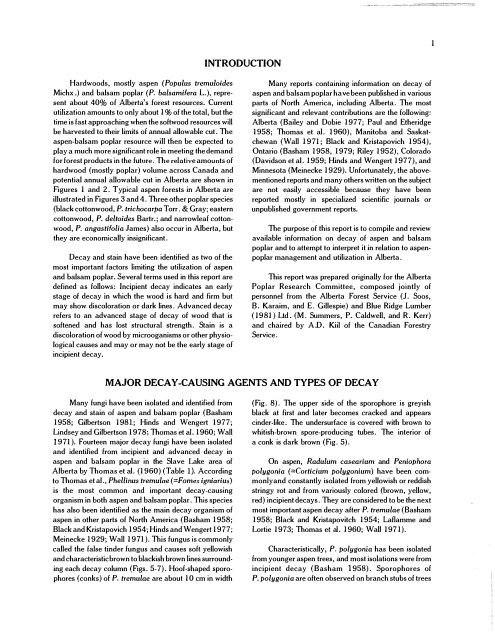
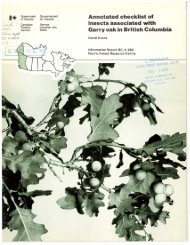
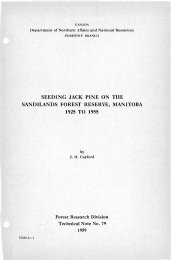
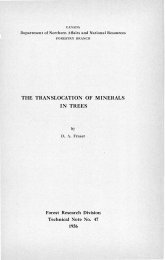
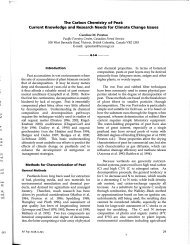


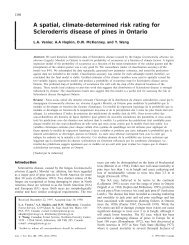

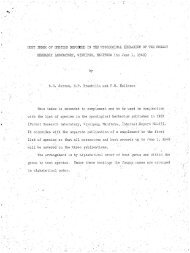
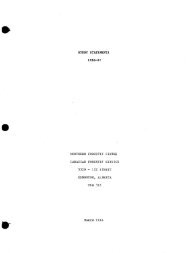
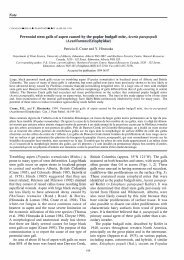
![Po],rell](https://img.yumpu.com/11946277/1/190x231/porell.jpg?quality=85)
